Tomatoes are one of a number plants in the vegetable garden that could use a little support. The main stem of a tomato plant isn’t sturdy enough to support the heavy load of fruit that sets on the plants.
So what’s the best way to support tomato plants? Well, there are as many different ways to support tomatoes as there are tomato varieties themselves! Stakes, cages, trellises—let’s talk about each of these different ways to support tomatoes.

Table of Contents
Why do my tomatoes need support?
Tomatoes (Solanum lycopersicum) are tall, sprawling vines that do not have a sturdy enough main stem to support the plant upright—especially when it is loaded with heavy fruit. Providing support for tomatoes not only makes it less work to maintain the plants, but it also produces higher yields, prevents cracking in the fruit, makes for easy harvesting, and helps prevent diseases like blossom end rot and anthracnose thanks to good air circulation.

What is the difference between determinate tomatoes and indeterminate tomatoes?
There are two main categories of tomato plants that can help give you an indicator of their size, and the type of support system they’ll need.
- Determinate Varieties: These types of tomatoes “top out” at a certain size and typically set fruit in generally the same time frame.
- Indeterminate Varieties: These varieties will continue to grow, flower, and set fruit for an entire growing season. They can grow as tall as 8-10 feet!
Most seed packets will tell you if the tomato variety you have is indeterminate or determinate.
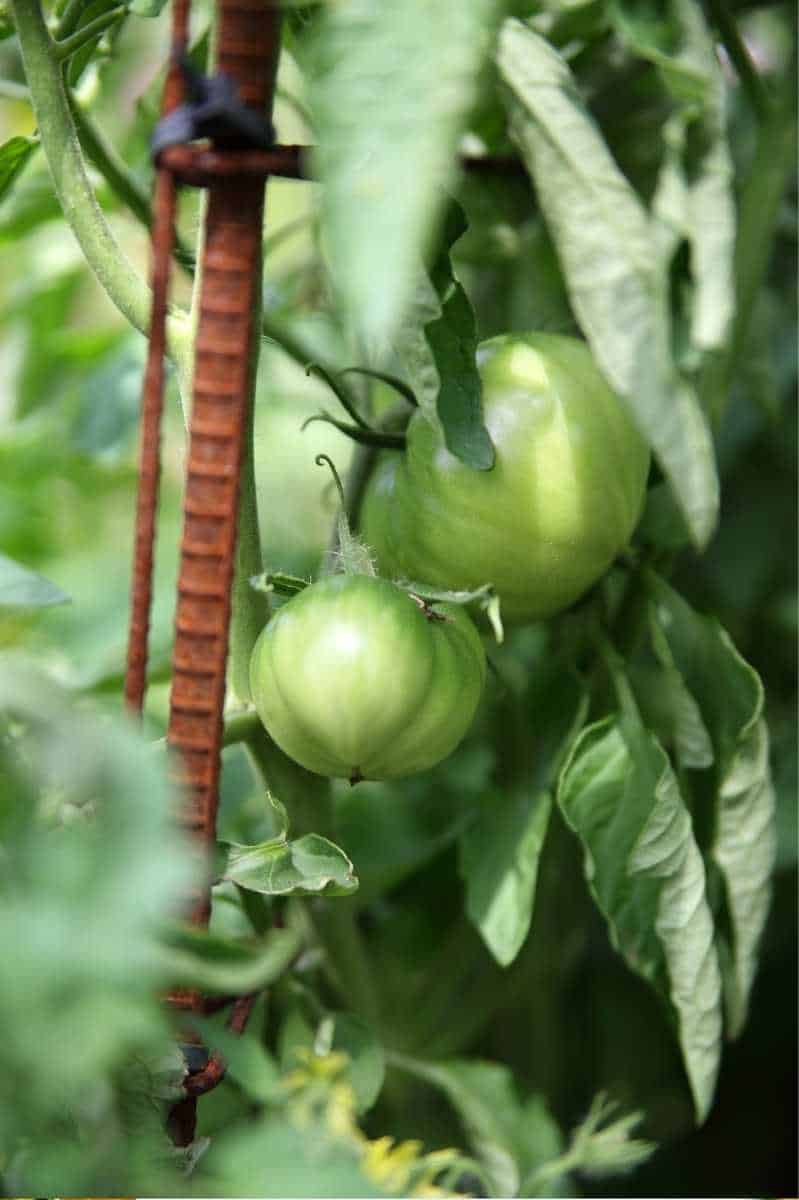
Can you grow tomatoes without staking or caging them?
Technically, you can let your tomatoes grow similar to other sprawling plants—like cucumbers or cantaloupes—but that’s just not the best habitat for yield, harvesting, or disease resistance.

There are certain tomato varieties that have been bred to be container or small space friendly that require little to no support. These bush varieties are typically determinate—meaning they’ll only grow to a certain height and will set tomatoes all around the same time.
What are some varieties of tomatoes that don’t need support?
There are a number of bush tomatoes out there that you can grow with little or no support. The best tomatoes for growing without support are compact plants with light fruit, such as cherry tomatoes, grape tomatoes, or plum tomatoes. Here are some of our favorites:
- Orange Hat Tomato
- Red Robin
- Beaverlodge 6806 Plum
- Ruby Crush
- Extreme Bush Tomato
- Veranda Red Hybrid
What are the four main methods of supporting tomatoes?
Almost every gardener has different methods for providing support for their tomatoes! But the most common methods are stakes, cages, or two kinds of trellises:
Tomato Stakes: Stakes are maybe the most classic way to support tomatoes. A narrow, tall (5-foot or taller by 1-inch wide) single stake is placed next to the stem of the plant. As the plant grows, it is tied to the stake using twine, zip ties, or other ties. The stake itself can be made of wood, bamboo, t-posts, fence posts, or branches.

Tomato Cages: Cages are probably the easiest way to provide support for your tomatoes. Tomato cages can be purchased at garden stores, or you can make a DIY tomato cage using fencing, cattle or hog panels, or concrete reinforcement mesh. The cages are placed around a plant when it is young, and as it grows, it grows through the cage openings.
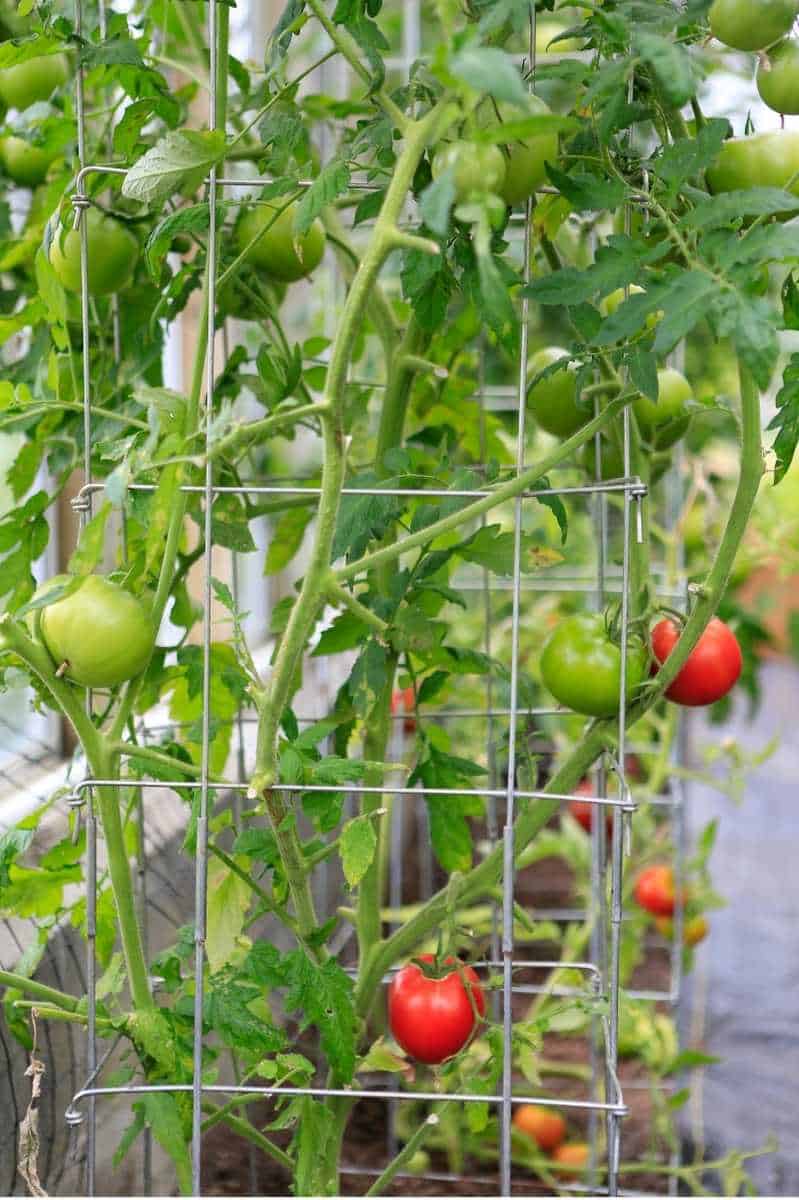
Traditional Trellises: Traditional garden trellises combine the properties of both stakes and cages. You place the trellis near the growing plant, and then use ties to attach new growth to the trellis. As the plant grows, it grows through the trellis openings, and the plant is supported.
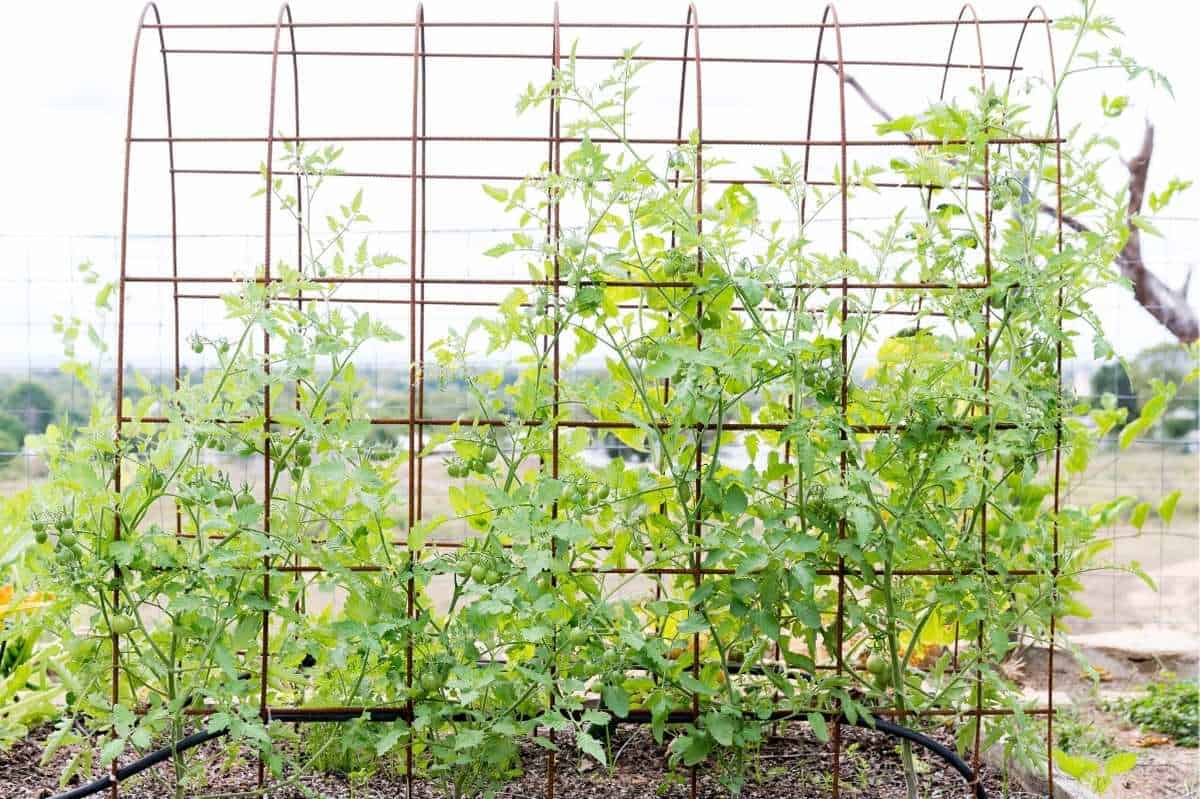
String Trellises: If you are growing a large number of tomato plants in a row, you might want to consider a string trellis—which is a soft trellis made from string. There are two main kinds of string trellises: a vertical string trellis, where the strings act in place of a traditional tomato stake, and a Florida weave string trellis, where string is woven between fence posts (typically t-posts) to create a structure for the tomato plants to grow through.
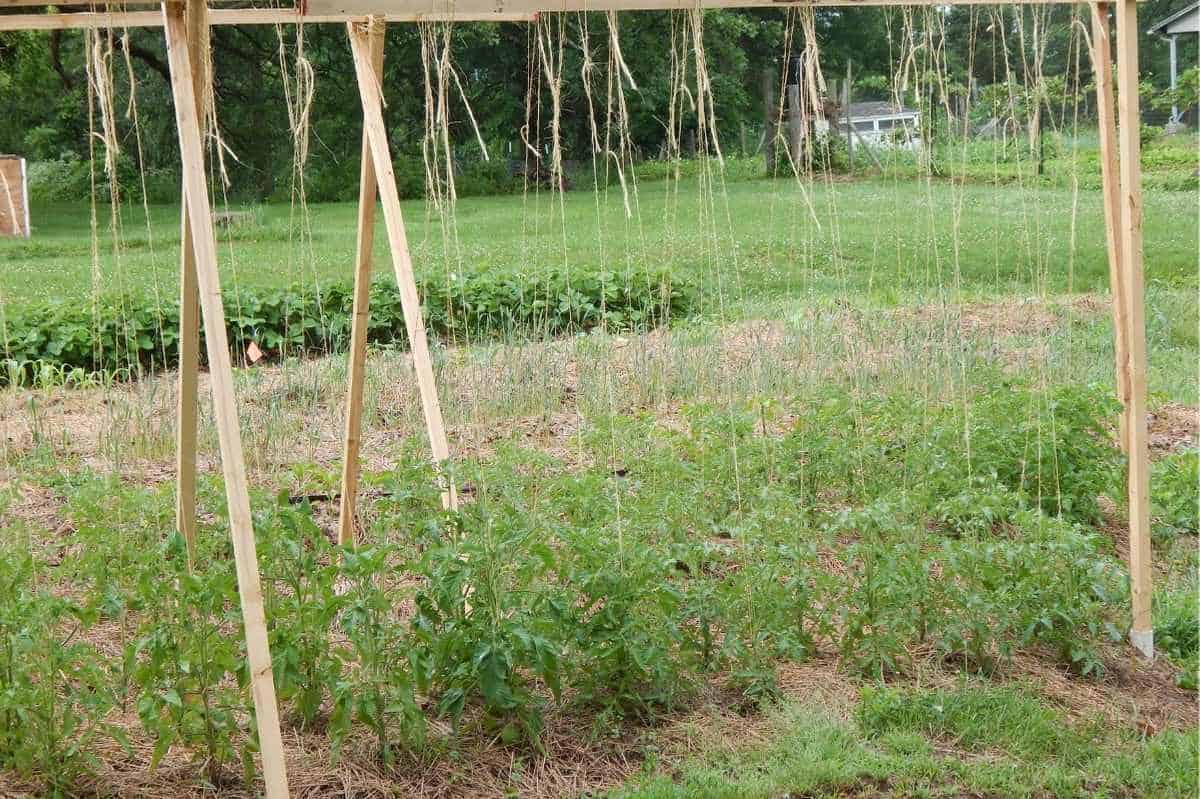
Is it better to stake, cage, or trellis tomatoes?
What works best in your garden depends a lot on your tomato varieties, your tolerance for maintenance, your garden layout, and even your weather (you’ll need to secure tomato cages for extra stability during summer storms). We have done all the major tomato support methods in the Growfully gardens, and we have landed on large, sturdy homemade tomato cages made from concrete reinforcement mesh as our favorite.
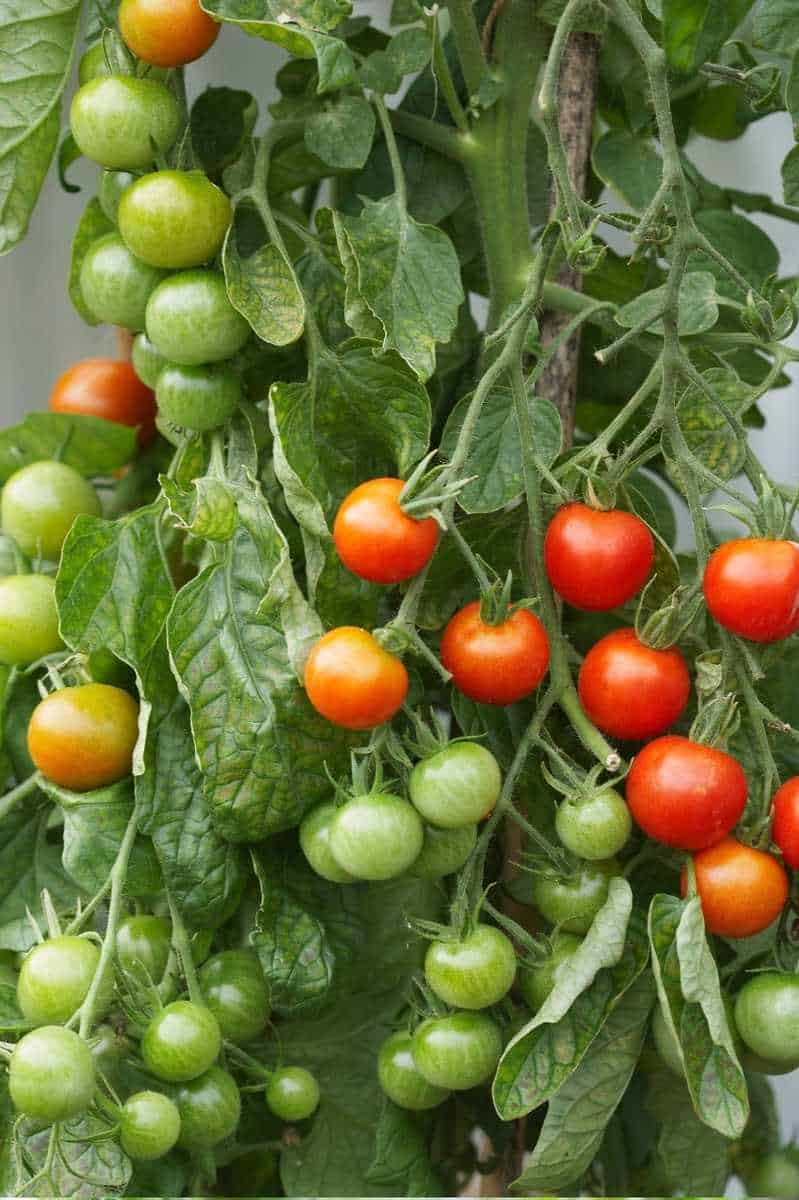
Tomato Stakes
How do you stake tomatoes?
Staking tomatoes is a relatively simple process, but it does require frequent maintenance to keep your tomato tied sturdily to the stake.
- Immediately after transplanting your tomato seedling, place a tall, narrow stake about 3-inches away from the base of the plant. Inserting the stake now prevents root damage.
- As the plant grows, loosely tie the main stem of the tomato plant to the stake.
- Continue to tie up the main stem of the plant as the plant grows.
Growfully Protip
You’ll probably need to add new ties to your tomato stakes every 10-14 days during the summer growing season.
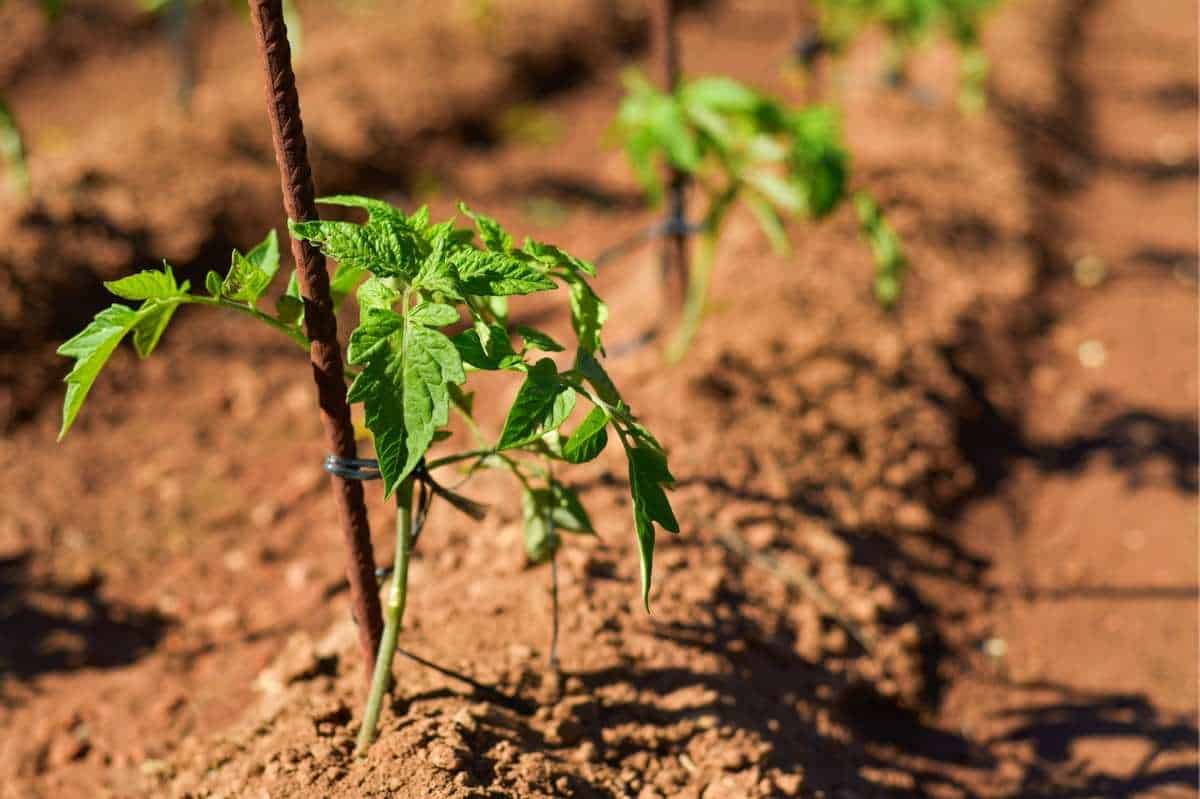
What can I use for tomato stakes?
A tomato stake can be any pole that is narrow and tall. Some good options are:
- Bamboo poles
- Dowel rods
- Branches
- Plastic poles
- T-posts
- Rebar
- Specifically made tomato stakes
How tall should tomato stakes be?
For indeterminate tomato plants, a 6- to 7-foot tall tomato stake would not be overkill. For determinate and bush varieties, you can get by with a shorter 4- to 5-foot stake.

How do you tie up tomato plants to stakes?
To tie tomato plants to stakes, take a length of twine, zip tie, piece of fabric, or tomato twine, and wrap it around the stem and the stake. Tie a sturdy knot at the end of the tie to secure it.
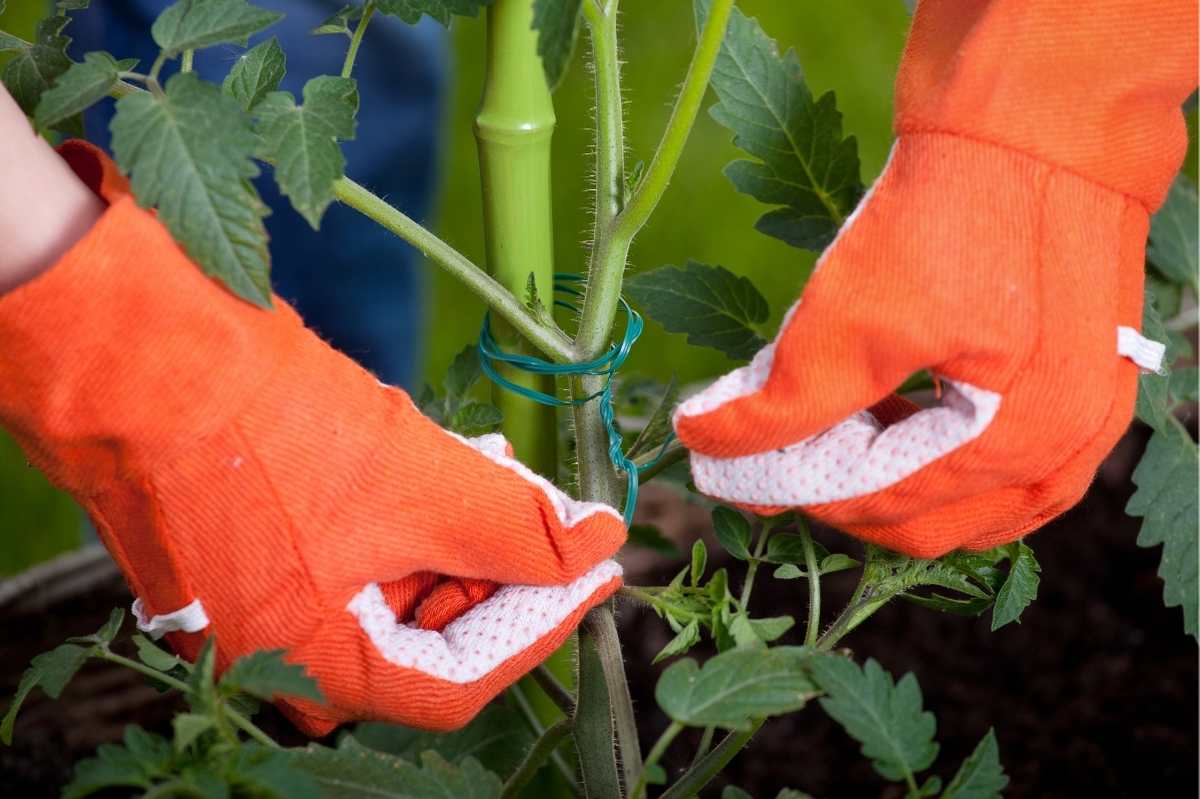
The most important thing to remember when tying your tomato stems is to tie them loosely. The tomato stems will grow and expand throughout the growing season, and you want to provide plenty of room to grow without choking the stem.
Growfully Protip
To make sure you are giving your tomato stems enough room to grow, you can place a thick marker or spoon handle between the stem and tomato stake when tying the ties. Pull out the marker or spoon when your knot is secure.

Tomato Cages
How big should a tomato cage be?
We recommend you get the biggest tomato cage you can find. The truth is, the vast majority of wire tomato cages you purchase from the garden store are too small for many tomato varieites (especially indeterminate varieties). They work great for supporting other nightshades like eggplants or peppers, though!
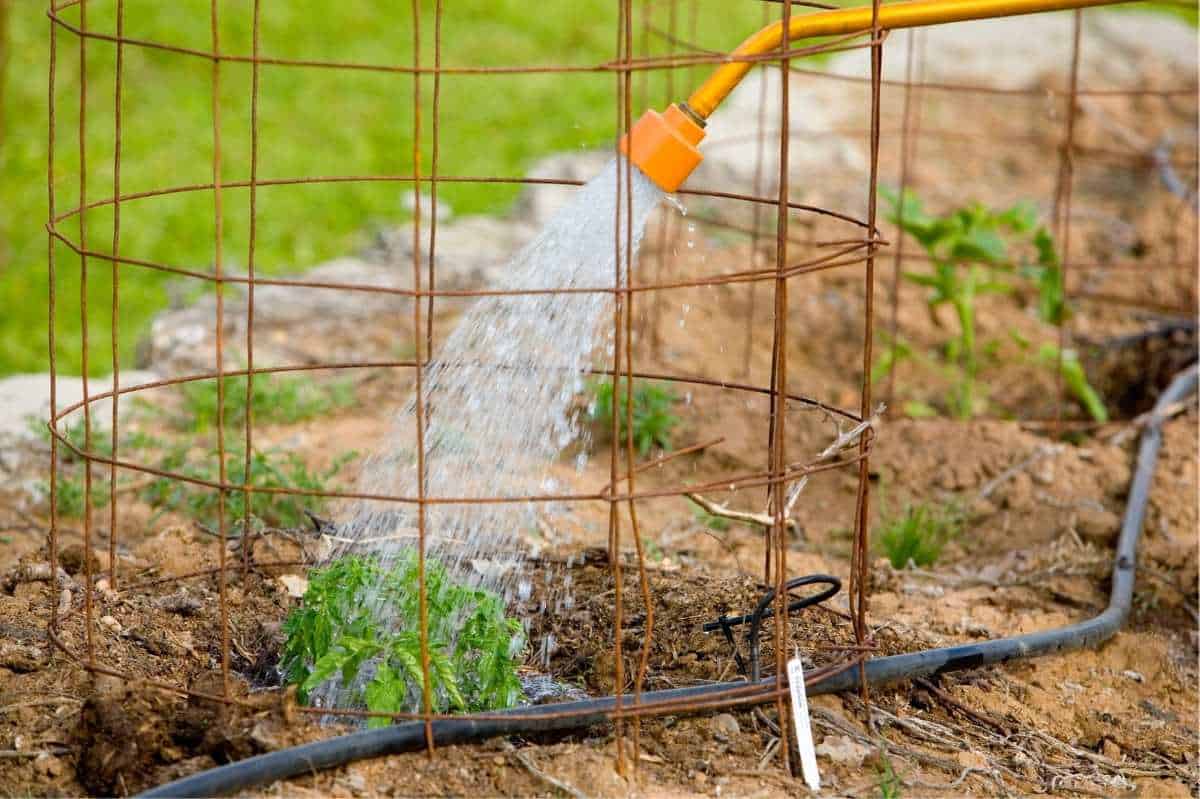
A general rule of thumb is that for large indeterminate tomatoes, you want a cage that is at least 60″ tall with a 18″ diameter at the largest point.
For determinate or bush tomatoes, you can get by with tomato cages that are 36″ to 48″ tall, with a 12″ or larger diameter.
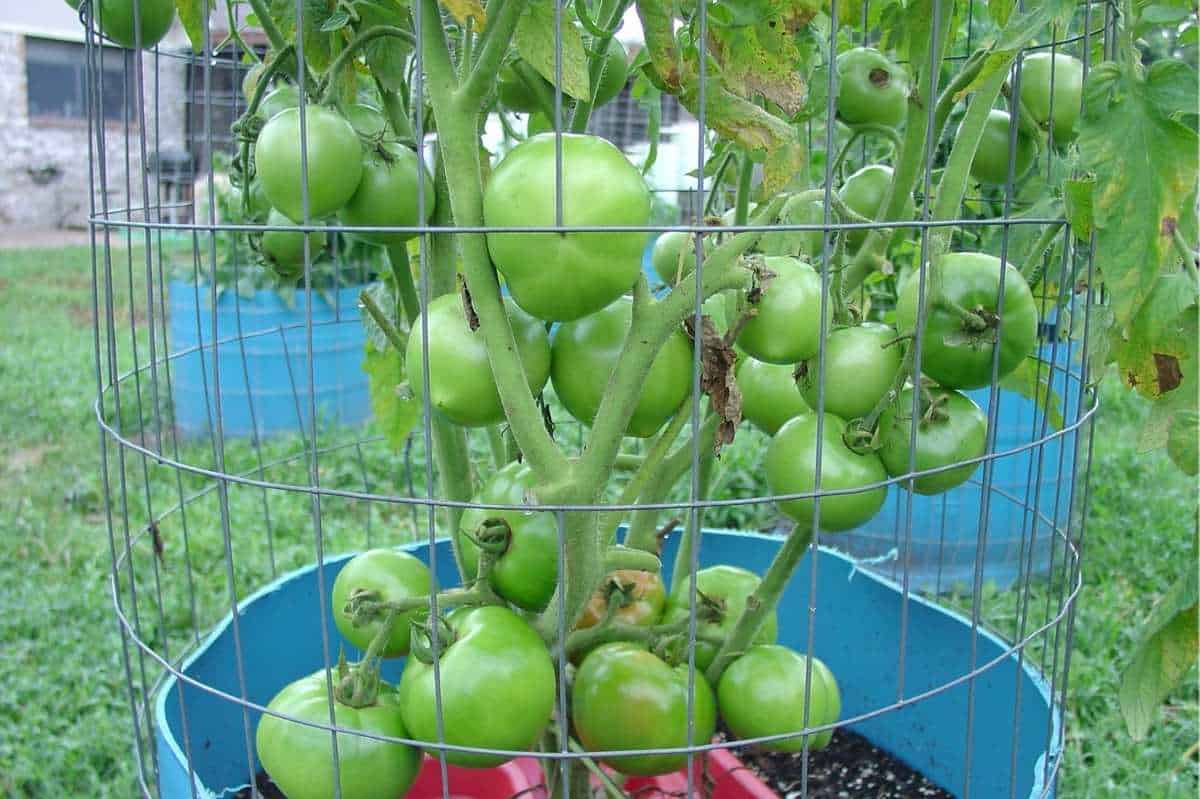
When should you put a tomato cage on?
Put your tomato cage on as soon as you transplant your tomato into its permanent spot. Do not wait to put on tomato cages until they are big enough to need them—typically you will damage the plant if you put a cage on them.
Growfully Protip
Especially in areas with lots of summer storms, it is vital to use fasteners to secure your tomato cages to the ground. We like using long landscape staples on the base of our cages.
What is the best kind of tomato cage?
You’ll frequently see the conical tomato cages sold at garden centers, but we do not recommend you use those for tomatoes (they are great for supporting peonies, eggplants, and peppers, though).
The best wire tomato cage we’ve found are cylindrical or cuboid in shape. They allow the tomato plant to have good support along the entire stem.

Where can I get tomato cages?
Cylindrical or cuboid tomato cages can be tricky to track down, so we typically recommend gardeners make their own cages (more on that in a sec). We have seen them sold at Gardener’s Supply.
Can I make my own tomato cages?
Yes, and in fact, if you plan on growing tomatoes year after year, we recommend you do! You can make your own tomato cages using hog or cattle panels, concrete reinforcement mesh, or metal fencing. Simply clip the correct length, form it into a cylinder, and then use strong pliers to wrap the cut edge around the opposite end to secure. Voila! High-quality, large, sturdy cages that you’ll never need to replace.
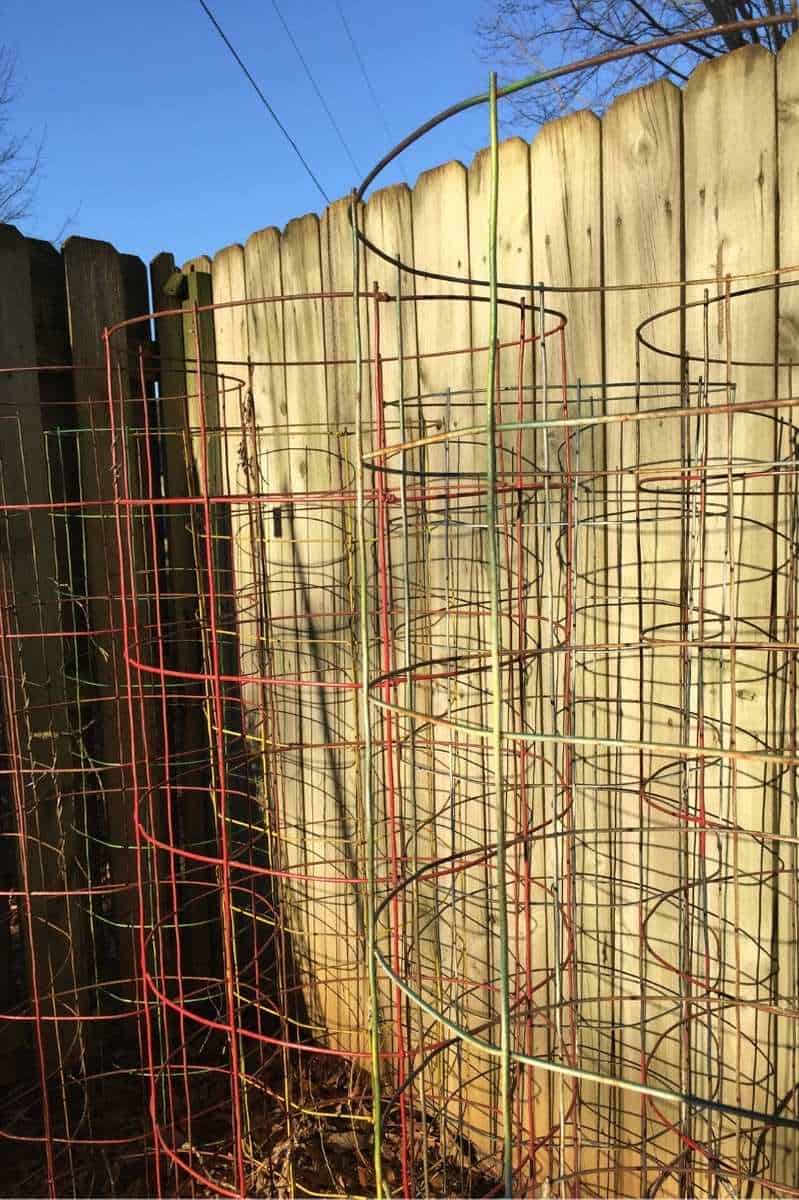
Traditional Trellises for Tomatoes
How do tomato trellises work?
Traditional garden trellises combine the properties of both tomato stakes and tomato cages. You place the trellis near the growing plant, and then use ties to attach new growth to the trellis. As the plant grows, it grows through the trellis openings, supporting the plant.

What’s the best kind of tomato trellis?
Any sturdy garden trellis that can be tied to will work well for a tomato trellis. The key is to make sure it’s tall enough—which can be tricky when purchasing store bought trellises. We have used two stacked cattle or hog panels as tomato trellises in the past with good results.
How do you tie tomatoes to a trellis?
Tie tomatoes to a trellis the same way you’d tie them to a tomato stake.
Tomato String Trellises
Here at Growfully, we think string trellises are the least fitting option for home gardeners who are just growing a handful of tomato plants. String trellises are common in greenhouses for commercial growers, and Florida weave trellises are a good option if you plan on growing a long row of the same kind of tomato plants—those aren’t common situations for home growers.
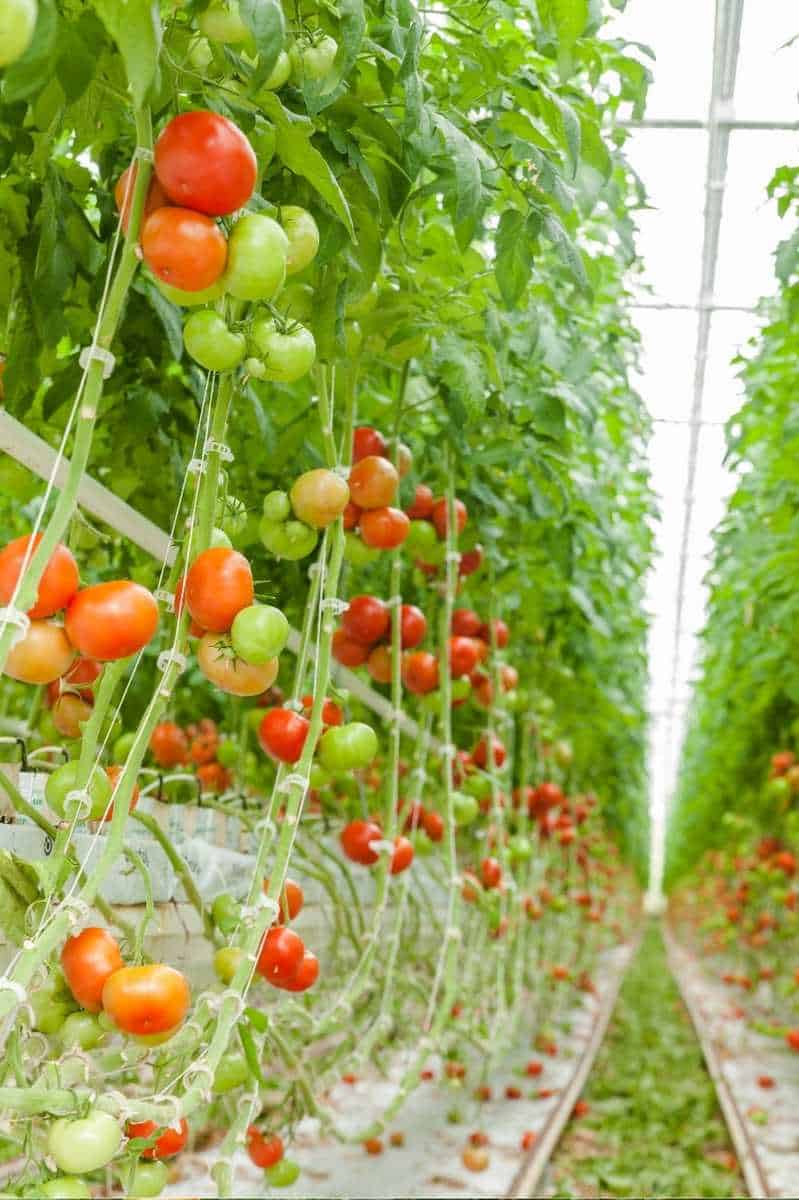
No matter how you support your tomatoes, we promise you’ll see increased yields and disease resistance, plus a much easier plant to maintain!

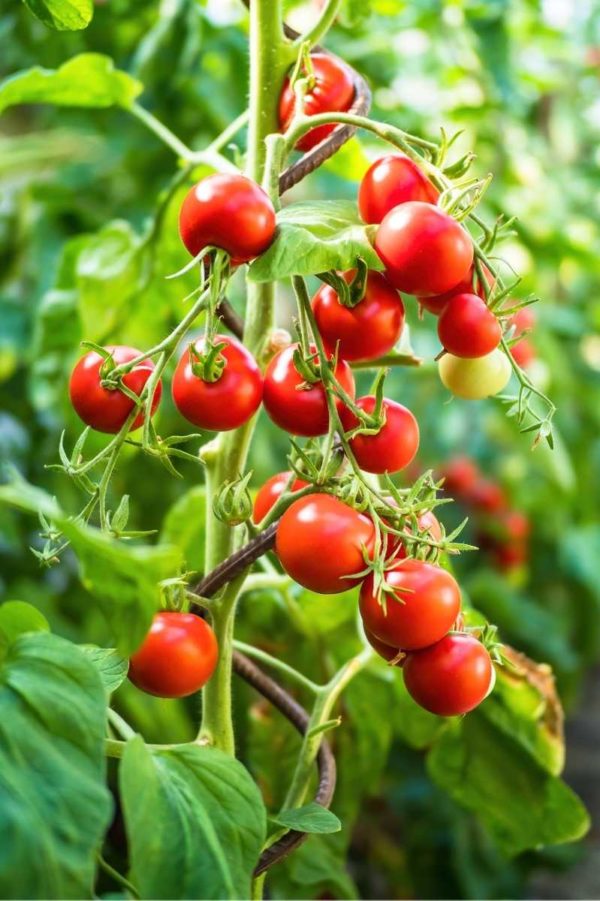






Great info! How do you use the concrete mesh to form a tomato cage? It sounds like a strong inexpensive option. Thank you.
We’re working on a post all about this! But for now, you cut a length the circumference you would like your cage to be using wire cutters. Then you form it into a cylinder, and bend the cut edge back to loop around the uncut edge to join. Make sure to use gloves!
Your recommend fencing for cages. What size would your recommend. I used 1 by 2 wood last year to support my tomatoes and that was to flimsy. I am using 17” vego garden raised beds this year to grow. I am considering putting T posts on each end of the bed and supporting a hog panel down the middle of the bed tying to each T post at the end and a support of fence in the middle. Do you think this will work? I live in West Lafayette, IN.
Thank you, Deb Lubelski
Yes! We’ve done this in the past (although we used 2″ x 4″s screwed into the ends of our bed to hold the cattle panel). It’s very sturdy, although most cattle panels are only 48-50 inches high, which can be too little for some indeterminate tomatoes.